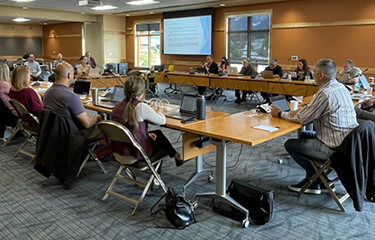Debate rages on impact of pollock trawler bycatch on declining stocks in Alaska

The North Pacific Fishery Management Council declined to take immediate action to limit pollock trawling that some have blamed on causing declines in populations of chum and chinook salmon, red king crab, opilio crab, and other species that come up in the tows of pollock-fishing vessels.
At the NPFMC meeting in Anchorage, Alaska, during the second week in December, representatives from Indigenous tribes and the crab- and salmon-fishing sectors pushed the council to take immediate action to close down trawling in vast areas of the Bering Sea, but the council deferred any potential action until 2023.
Though pollock have been categorized as a mid-water pelagic species, trawlers targeting the species in the Bering Sea run their nets deep when their sonars indicate dense concentrations of fish near the ocean bottom. Some fisheries scientists have blamed pollock trawlers for drastic declines of red king and opilio crab stocks in the Bering Sea and declines in salmon runs outside of Bristol Bay; for more than a decade, the Yukon River has not seen appreciable runs of chinook and chum salmon, and the experience is repeating itself with the Kuskokwim River. Resulting closures of commercial and subsistence fishing opportunities have impacted communities stretching between Emmonak, at the mouth of the Yukon, to villages dotting its tributaries in the Yukon Territory, more than 2,000 river miles upriver from the Bering Sea.
Recent salmon bycatch numbers gleaned from observer reports and genetic stock analysis by the Alaska Department of Fish and Game found 16,796 chinook salmon were Coastal Western Alaska stocks, and of those, 670 chinooks were stocks bound for the Middle Yukon, with 729 fish headed for the Upper Yukon. An estimated 16 percent of the chum salmon bycatch is made up of Coastal Western Alaska stocks.
While no conclusive evidence exists offering a direct link between declines in Alaska’s crab and salmon stocks and pollock fishing, those pushing for a closure of the pollock trawl fishery said it must be removed as a variable following the conservation principle of stock management.
Shutting down the trawl fisheries, however, would have a significant economic impact on at least 65 western Alaska villages – and their 28,000 residents who receive funding under Alaska’s Community Development Quota program. With combined assets of USD 1.4 billion (EUR 1.3 billion), the six economic development groups belonging to the CDQ program – several of which own pollock trawlers and lease shares in others – grant millions of dollars to local Alaska communities for schools, roads, and other public infrastructure.
Given the evolving complexity in the economic structure of the pollock fishery, NPFMC members and those pushing the council for action have expressed concern about the legal consequences of any possible action the council may take, with concerns over compliance with the National Environmental Policy Act, the Magnuson-Stevens Act, and Administrative Procedures Act hobbling the council’s ability to act.
“It is not solely litigation that makes the process too slow,” Alaska Longline Fishermen’s Association Executive Director Linda Behnken said. “The council process has to comply with NEPA and MSA and APA.”
At its December meeting, the council asked its 12-member salmon bycatch committee to draft a set of recommendations and present them over the council’s next two meetings on 6 February and 3 April. The recommendations will then come up for a vote by the council on 5 June.
Lindsey Bloom, a campaign strategist with SalmonState, which seeks to preserve Alaska’s wild salmon runs, said the council’s lack of action is causing harm to the state’s fisheries.
“The council has decided to protect the status quo and allow the trawl fleets to continue catching and discarding prohibited species such as chum salmon, chinook salmon, and crab while entire western Alaska runs and crab stocks are in collapse. This is a total failure in fisheries management,” Bloom said. “The council process is not equipped to adequately manage fisheries in this era of dramatic change in our oceans and rivers. That is a glacial pace for responsive fisheries management and will likely result in eleventh-hour actions that are simply too little too late.”
Reporting by Charlie Ess
Photo courtesy of North Pacific Fishery Management Council






Share